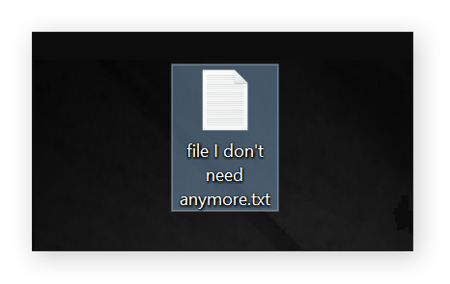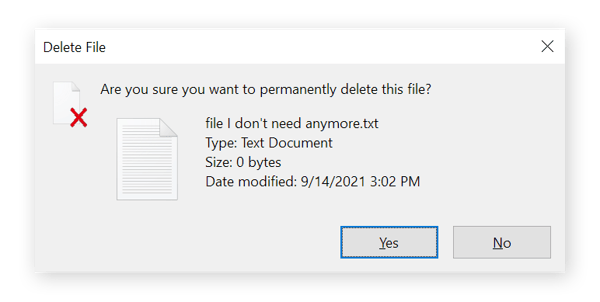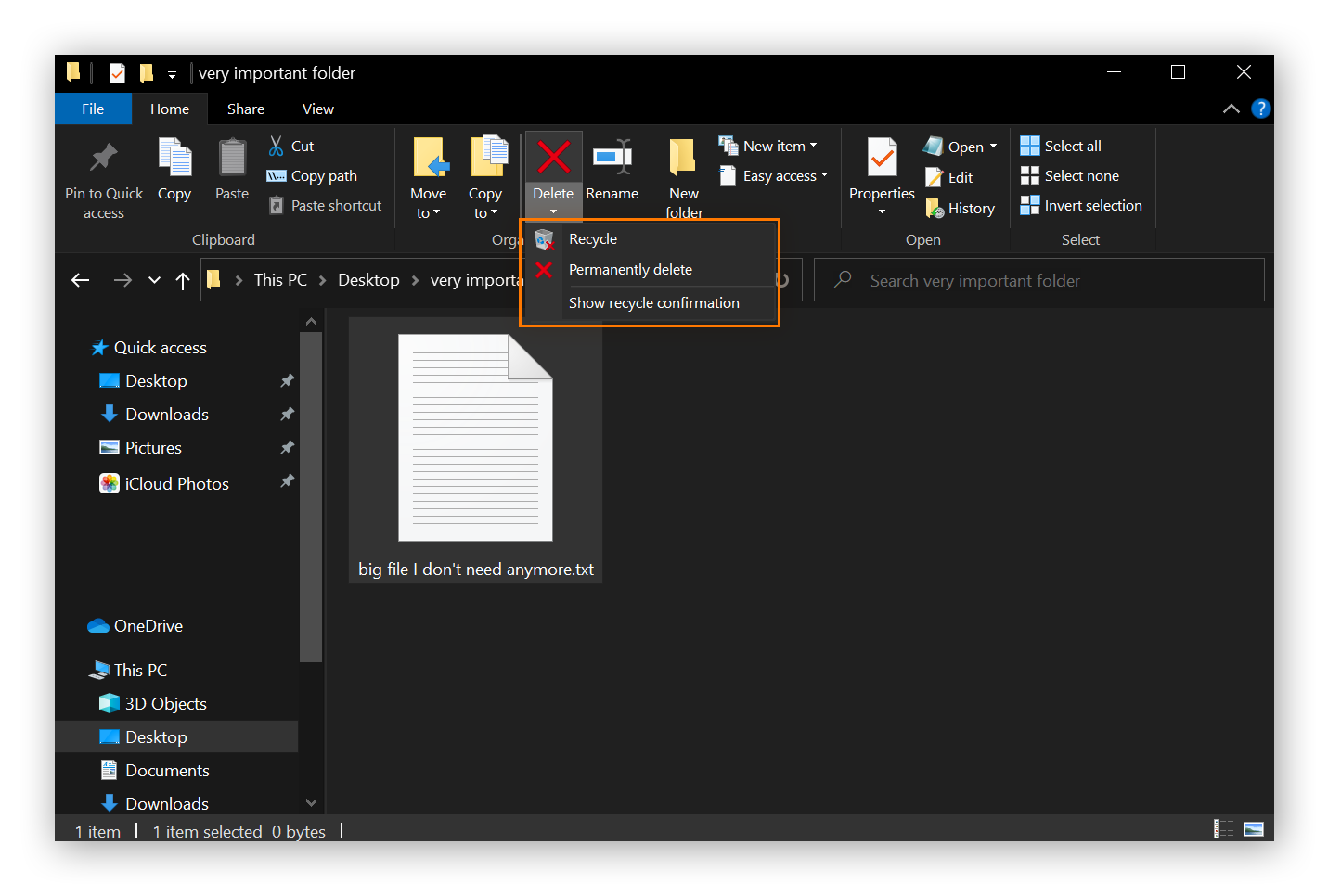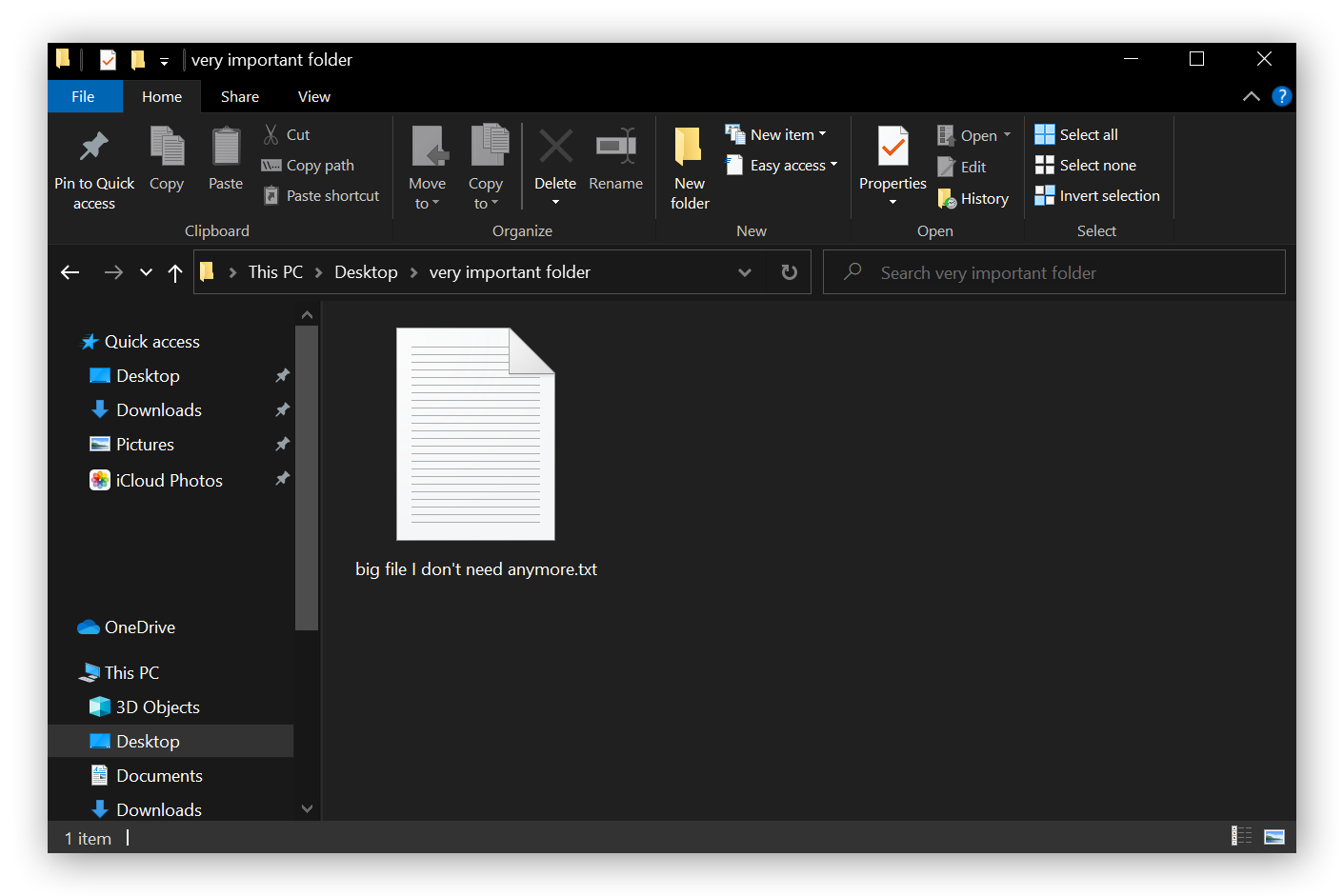How To Permanently Delete A File On Windows 7
Use Keyboard shortcuts to delete files
You can skip the Recycle Bin by selecting a file and clicking Shift + Delete (holding downwards the Shift key and so pressing the Delete fundamental).
Here'southward how to permanently delete files on Windows using keyboard shortcuts just:
-
Click on the file one time to highlight it. If the file is saved directly on your desktop, click on it there. Otherwise, find it and click to highlight it in Windows File Explorer.

-
Hold downwardly the Shift key and printing the Delete key. (Remember that the Backspace key isn't the same as the Delete fundamental.)
-
Click Aye on the window that pops up.

This is how you can delete files in Windows without using the Recycle Bin. With keyboard shortcuts, you don't need to carp with elimination the Recycle Bin to become rid of files — they're already gone.
In some cases, files you think are permanently deleted are actually still recoverable. That'south because Windows doesn't turn the space on the disk that was belongings the file dorsum into a blank slate. Instead that disk space is marked as set to be overwritten. It might be overwritten by something you lot practice immediately subsequently, or that disk space might hang around for much longer.
Make certain that information doesn't linger with a tool like Avast Data Shredder. Data shredder tools are particularly skilful for wiping temporary files, where things like credit card numbers might get stored, and making sure deleted files can't ever be recovered.
If yous're looking to free upward more deejay space on your computer, or if you lot observe your machine suffering from 100% disk usage, cheque out our defended guides.
Utilize the File Explorer Ribbon to delete files
Yous can delete files in Windows past using the File Explorer, which is the binder that holds all your files. Find the file you want to go rid of, then use the Windows File Explorer Ribbon to delete it. Hither's how:
-
Click the folder icon in the taskbar at the bottom of your screen or printing the Windows Key + E to open Windows File Explorer.

-
Navigate to your file and click it to highlight it.

-
Click Delete in the File Explorer Ribbon at the elevation of the window, or click the arrow underneath the Delete choice and select Permanently delete. Clicking Delete sends the file to the Recycle Bin, while selecting the Permanently delete selection deletes the file for proficient.

Use Powershell to delete files
More advanced users can utilize Powershell or the Windows Command Prompt to permanently delete files. Here's how to employ Powershell to delete files:
-
Type "powershell" in the Commencement Carte du jour at the bottom of your screen.
-
Printing Enter if Windows PowerShell is highlighted, or click the option for Windows PowerShell.

-
Blazon Remove-Detail -path c:\[Filename] -recurse and printing Enter. This will delete everything in the folder, including whatever files and folders within that binder.

Utilise software tools to delete files
Some software tools will delete files past the betoken of recoverability. Here are a few apps you can utilise to permanently delete files or wipe a folder clean:
-
Avast Information Shredder — a built-in feature of Avast Premium Security
-
WipeFile
-
Eraser
File shredding software uses random information to write over the infinite on your deejay where the file used to be stored. Then, if anybody tries to restore files or data from that space, they'll find just random data.
Despite the many wiping options, only one overwriting laissez passer is necessary. Merely if y'all're feeling extra cautious, file shredding programs can overwrite files with random data many times. Using data shredder tools is the virtually secure manner to delete data, because recovery is substantially incommunicable afterward.
If you want to shred files or otherwise clear out space on your estimator, a PC optimization app is a great tool to get the job done automatically.
Use the right-click menu to delete files
Another way to delete a file is to right-click it, on your desktop if it's stored in that location or in your File Explorer. Here'south how to delete a file past correct-clicking it:
-
Go to the folder where the file is stored.

-
Right-click the file and select Delete.

Deleting files by right-clicking them sends them directly to the Recycle Bin. To permanently delete all the files in your Recycling Bin, minimize all your open windows, right-click the Recycle Bin on your desktop, and select Empty Recycle Bin.
What happens when you delete a file?
Elimination your PC's trash bin isn't enough to securely erase the data in those files. Anyone with access to your hard bulldoze tin can withal easily recover files or other information in your Recycling Bin. Whenever you lot sell, lend, or hand your reckoner to someone to repair information technology, make clean that PC thoroughly.
If you have an Apple computer, cheque out our article on how to permanently delete files on a Mac . And find out how to make clean your Mac with some of the best Mac cleaning software effectually.
To understand why anyone with access to your hard drive can recover the data in your deleted files, allow's await at what happens inside each type of drive when you delete a file.
Hard Bulldoze
When you delete a file on a hd (HDD), Windows sections off the space that the file took upwardly and marks it every bit overwritable. But earlier that infinite is overwritten, the data yet lingers in that location. Those files can hang effectually for a very long time later deletion, even if yous've defragged your PC.
And if you're concerned with data security and privacy, brand certain to go 1 of the best security apps along with strong PC cleaning software for your PC.
SSD
Solid-state drives use a much different file storage system than HDDs. Since the technology supports only so many writes, SSDs spread information out across the bulldoze, constantly consolidating to make the best use of space.
On SSDs, information gets moved around all the time, increasing the chances that parts of a file will survive. Recent SSDs come with a feature chosen TRIM that overwrites deleted data, so less data remains afterwards a deletion.
Another option on SSDs is to utilise Secure Erase, which, as the proper name suggests, deeply removes all data. A new feature of Secure Erase takes advantage of SSDs with encryption. The decryption central gets deleted instead of the data, saving the drive some write cycles and preserving its lifespan.
Learn more about the difference between SSDs and HDDs here.
Gear up your Windows PC problems with Avast Cleanup
While wiping leftover data from your drive is useful, it won't have any effect on your computer's performance. To fully optimize your computer, you demand a tool for cleaning up junk, bloatware, and unused programs.
Avast Cleanup performs regular, automated maintenance to help fine-tune and increase the speed of your PC. This includes deleting temporary browser and cache files, updating your programs, defragging your hard drive, and much more. Information technology'south the perfect tune-upwards tool to keep your computer running merely as smoothly every bit the solar day you got it.
Source: https://www.avast.com/c-permanently-delete-files
Posted by: clinehameaced.blogspot.com

0 Response to "How To Permanently Delete A File On Windows 7"
Post a Comment